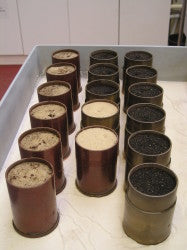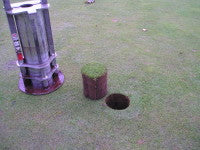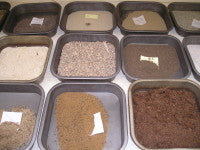Lab analysis
 There are many tools available in the sports turf industry to aid Greenkeepers, Groundsmen, Golf Course Architects and Agronomists in making the right choices for their course or pitch. Laboratory analysis is one of those key services where decisions can be based on hard facts rather than guesswork.
There are many tools available in the sports turf industry to aid Greenkeepers, Groundsmen, Golf Course Architects and Agronomists in making the right choices for their course or pitch. Laboratory analysis is one of those key services where decisions can be based on hard facts rather than guesswork.
We visited European Turfgrass Laboratories Ltd (ETL), based in Stirling, Scotland, who aim to provide a complete testing facility to the industry. The company has been in existence since 1996, set up by a group of Agronomists and Contractors who needed to be provided with a quick turnaround with accurate results. At the time, there was much inconsistency in analysis and sometimes a long wait for the feedback. In 1998, the laboratory moved to Stirling Enterprise Park, where it's still based today. The Park was the former John Player (cigarette manufacturer) premises, donated to the town.
ETL became an A2LA (American Association for Laboratory Accreditation) accredited laboratory in 1997, one of only ten such laboratories in the world (five of which are in the USA). The USGA recommend only the use of A2LA-accredited laboratories for soil physical testing.
There are many benefits for choosing to use an A2LA-accredited laboratory. These laboratories have strict policies and procedures which they must follow to ensure the consistency, accuracy and reliability of their testing results. Every two years, an assessor visits each laboratory for a 2-3 day period - the competence of the staff is assessed, they are asked to demonstrate their testing techniques, the quality management system is reviewed and the premises of the laboratory are checked for their suitability to accommodate the testing procedures. Laboratory equipment is calibrated on a regular basis, traceable to national standards. Reference standards are tested on a daily basis to run alongside test samples to ensure that the equipment is functioning normally.
Each accredited laboratory is assessed for their Scope of Accreditation. The Scope of Accreditation is a list of tests in which the laboratory has been shown to demonstrate ongoing competency. When choosing which laboratory to use, asking for this information could help you decide which laboratory to use.
Accredited laboratories are required to participate in a relevant proficiency testing programme. Samples are tested four times per year and statistically analysed. Any outlying results are investigated and appropriate corrections in the laboratory are made. These checks are an important factor in ensuring the quality of the test results.
So, why test?
Testing can provide data to help with:
• Selecting materials for new construction projects
• Identifying problems with rootzones or topdressings
• Recommending soil nutrient levels
• Ensuring materials are compatible
• Choosing suitable bunker sand
• Determining suitable construction depths for different materials
• Ensuring irrigation water is fit for use
 Using an independent laboratory is recommended, as an independent laboratory has no vested interest in selling a particular product to you. Quick, accurate, reliable test results are a must - check with the laboratory you use that they have the resources to be able to meet your deadlines. But, please be aware that some test methods take a few days to complete!
Using an independent laboratory is recommended, as an independent laboratory has no vested interest in selling a particular product to you. Quick, accurate, reliable test results are a must - check with the laboratory you use that they have the resources to be able to meet your deadlines. But, please be aware that some test methods take a few days to complete!
The role of the laboratory is critical in any successful construction. Sharon Bruce, Laboratory Manager & Director of ETL, provides a more detailed insight into the usefulness of test data in choosing the right materials for a project:
Test Sequence for a New Golf Green Construction - How Can a Laboratory Help?
After choosing which A2LA-accredited laboratory to use, the next step is sourcing the possible construction materials that are available close to the project.
Choose potential sand for the greens rootzone and select drainage gravel for use in the golf green construction. Ask the supplier of the products to send small samples of each potential material to the laboratory. Always check that each supplier has the volume required to supply you through the entire construction.
The particle size distribution and pH of the sand should be tested. The gravel should also be tested for its particle size. When these results are available, the laboratory will be able to tell you which sand is compatible with which gravel - this is whether they "bridge" together. Choosing materials which don't bridge together (without the presence of an intermediate layer) can have disastrous effects on the performance of the green. This is based on engineering principles that rely on the largest 15% of the sand particles bridging with the smallest 15% of the gravel particles. This is calculated mathematically and all results are compared to the 2004 USGA Recommendations.
 The next step is to select which organic or inorganic amendment is to be used in producing the greens rootzone. Organic amendments include peat, soil, compost (aged for at least 1 year), rice hulls, finely ground bark or sawdust. Inorganic amendments include zeolite, calcined diamtomites or calcined clays (porous ceramics). The laboratory will be able to inform you whether these products satisfy the USGA criteria and hence, whether they will be suitable to mix with the selected sand.
The next step is to select which organic or inorganic amendment is to be used in producing the greens rootzone. Organic amendments include peat, soil, compost (aged for at least 1 year), rice hulls, finely ground bark or sawdust. Inorganic amendments include zeolite, calcined diamtomites or calcined clays (porous ceramics). The laboratory will be able to inform you whether these products satisfy the USGA criteria and hence, whether they will be suitable to mix with the selected sand.
After the selection of the initial products, the laboratory plays an important part in designing the rootzone mix. The laboratory will test various rootzones mixed from varying ratios of sand:organic or inorganic materials selected for use. Each rootzone should be tested for its particle size distribution, pH, particle shape, organic matter content, saturated hydraulic conductivity, bulk density, total porosity, air-filled porosity and water-filled porosity. Again, the results are compared to the 2004 USGA Recommendations.
The test results can be used to help determine which rootzone is going to be best for your project needs. Next, is to prepare a small bulk mix and submit this to the laboratory for testing. This is to ensure that the bulk mix rootzone is comparable to the laboratory-developed rootzone.
 Assuming that the bulk mix is satisfactory, the key to a successful construction is a sound quality control programme, during the rootzone blending phase. Changes to either the sand or the organic/inorganic amendment, or the proportions used in the rootzone, can influence the physical properties of the rootzone. The laboratory recommend checking the consistency of the particle size distribution and organic matter content at regular intervals. This enables the rootzone blender, if necessary, to make adjustments to the organic/inorganic amendment to maintain the desired physical properties. Every 1000 tonnes of production should be sampled and submitted to the laboratory for a full USGA suite of testing.
Assuming that the bulk mix is satisfactory, the key to a successful construction is a sound quality control programme, during the rootzone blending phase. Changes to either the sand or the organic/inorganic amendment, or the proportions used in the rootzone, can influence the physical properties of the rootzone. The laboratory recommend checking the consistency of the particle size distribution and organic matter content at regular intervals. This enables the rootzone blender, if necessary, to make adjustments to the organic/inorganic amendment to maintain the desired physical properties. Every 1000 tonnes of production should be sampled and submitted to the laboratory for a full USGA suite of testing.
Every load of material delivered on site should be sampled. Each sample should be given a unique identification - the delivery date, delivery note number, and initials of the sampler. Retain each sample in a safe, dry storage place just in case there are any problems with the rootzone. If there are, at least, that specific delivery can be tested at the laboratory and problems readily detected.
All too often, the laboratory is asked to check rootzone samples that have poor performance characteristics in an already constructed green. And, again, all too often, if the gravel/rootzone had been tested prior to the construction, it would have been deemed unsuitable for use. The cost of testing is a mere fraction of the cost of replacing a green.
Why leave anything to chance, when there are independent and accredited laboratories which are there to provide reliable back-up and peace of mind?
